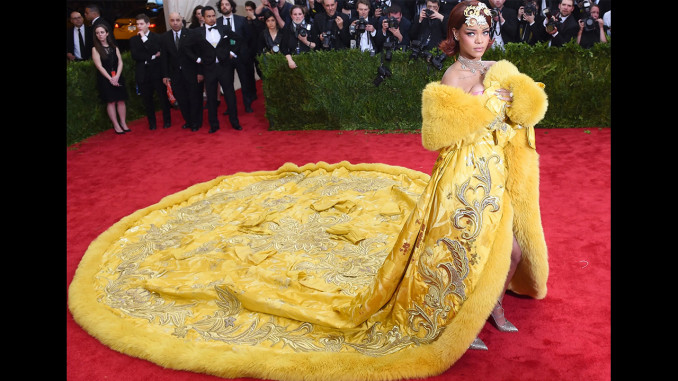
The fashion industry is a worldwide enterprise that exerts a big influence on how people see themselves and the societies they live in. Fashion has now also become a subject for museum exhibitions, including the current one at the Legion of Honor in San Francisco. This exhibit showcases the work of Chinese fashion designer, Guo Pei. She came to the attention of the U.S. public in 2015, when she loaned a spectacular bright yellow dress to the singer, Rihanna, who had seen it on line and wore it at the Metropolitan Museum of Art Gala in New York. The dress had a bell-shaped skirt and cape, lavishly embroidered in gold and silver thread. It took two years to complete and cost $1million!
Guo Pei’s work raises many questions about clothing and status. It also contrasts work that is done by hand, versus manufacturing. China’s current reputation is for fast fashion, clothes made quickly and cheaply. Guo Pei’s fashion workshop, Rose Studio, creates a very different style of quite expensive clothing that combines art, history and theater. She uses many fabrics and other materials in very unique ways, drawing from Western and Eastern traditions, embedding history into the designs.
Guo Pei’s fashion is greatly inspired by her grandmother, who grew up during the last Chinese Imperial Dynasty, before the 1911 Revolution, which led to the foundation of the Chinese Republic. When Guo Pei was young her grandmother glorified the high and fancy fashion designs that had existed for the upper classes in her grandmother’s youth.
Guo Pei grew up during the Chinese Cultural Revolution from 1966-76, which aimed at purging the remnants of traditional Chinese society, and solidifying the control of the Mao regime. It was a period of great turmoil and repression and certainly not a time to develop expensive and imaginative fashion designs. In fact, during this period, high-ranking families began to sell off their court dress to collectors from outside China. It was dangerous to have those things, let alone wear them. As a consequence, entire industries of handmade work died out.
Later in the 1990s. when Guo Pei went to a state-sponsored fashion school, she began developing her own unique fashion designs, somewhat along the lines of her grandmother’s descriptions. Her collections go from futuristic outfits to porcelain-inspired robes. She even designed clothing for the wives of Communist Party officials. Guo Pei’s work, like all high-priced fashion, is certainly not for the masses to wear but it is for them to make! But to make her creations she had to recruit workers to be trained to weave, dye, cut, sew, and embroider these clothes.
In China, a peasant class mobilized behind the Communist Party and overthrew an exploitative hierarchy in 1949. It outlawed the practice of foot-binding, keeping women’s feet the size of a child’s feet, so they could not walk without assistance. While Guo Pei has stated that she believes in feminine power, her shoe designs seem to express the opposite. They lift the wearer many inches off the floor, so to walk in them you have to be supported by other people, like in the dynastic past.
Her extraordinary costumes are beautiful, disturbing and contradictory and certainly challenge our usual idea of high fashion as you can see here.

